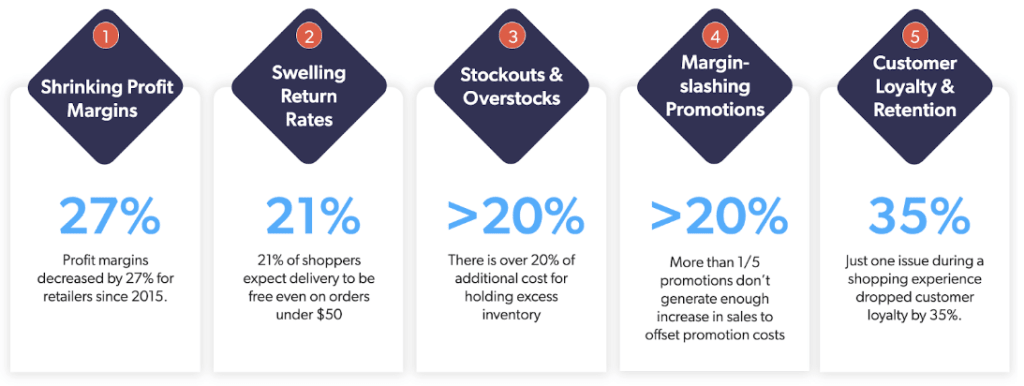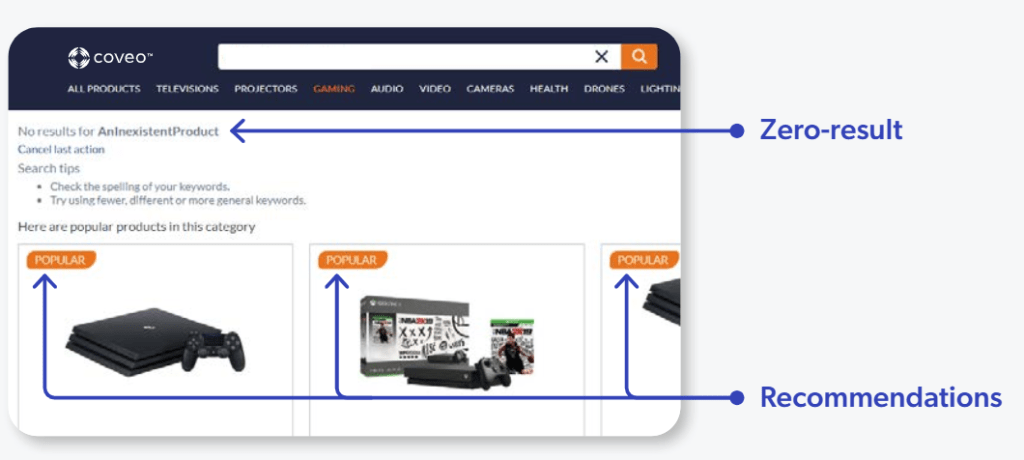Profitability issues have been plaguing ecommerce sites over the past years. In many cases, the fast-growing online channel is the least profitable because same-day delivery and hassle-free returns made popular by marketplaces and digital natives chip away at increasingly thin margins.
When this is coupled with reduced customer loyalty and markdowns driven by surplus inventory, it is easy to see why addressing retail’s profitability challenge is more important and urgent than ever.

It is natural to ask, then, whether implementing a Conversion Rate Optimization (CRO) strategy might be the key to mitigate if not address the profit shortfall.
CRO can be extremely effective and greatly contribute to driving sustainable growth.
However, CRO should be understood as just one specific piece in the larger puzzle of improving retailers’ bottom line. We look at the opportunities – and the cautions.
What Is Conversion Rate Optimization (CRO)?
First things first, though. What is CRO?
Simply put, Conversion Rate Optimization (CRO) refers to the systematic effort to find ways to improve the conversion rate on your website. According to Baymard Institute, “a better user experience (UX) on your site naturally leads to more conversions, so UX and CRO are closely linked.”
CRO works by improving the shopping experience to drive a specific desired action. That desired action can vary from business to business but an ecommerce conversion rate is the percentage of website visitors who purchased something from your online store. Look to at analytics around a micro conversion – such as add to cart, signing up for a service, or filling in a form.
Take a look at the analytics for each of these events. For example, if your online store is getting 10,000 visitors and 100 conversions for a set period, that means your store’s conversion rate is 1%. What is a good conversion rate?
While this varies from vertical to vertical, an average ecommerce conversion rate is around 2.2%. A 2.5% – plus conversion rate should be the baseline goal for your online store. Once you are able to achieve that, then you can move on to more advanced conversion rate tactics.
But conversion optimization doesn’t just happen. Retailers need to proactively look for opportunities to improve the user experience.
Conversion Optimization Best Practices
To determine where you have CRO opportunities, look at user behavior and customer journeys and identify which are successful – and which can be improved.
For instance, you may identify your most loyal customers such as those returning to your site after a long absence – and offer personalized product recommendations on the product page. For these visitors, target them with tailored messages and social proof at key moments in their journeys.
Similarly, you may want to try to optimize customer journeys by removing elements of friction and dead ends. In particular, zero-results pages are a big problem for conversion rates. When customers try a search and get no results, there’s a high risk of site abandonment. Most no-result pages typically offer few or no paths for customers to get back on track, making it a user experience dead end.

Whatever the reason for a customer reaching a zero-results page, when there’s little or no helpful guidance or content on the page, your website visitor has two options: either think up a whole new product-finding strategy or abandon the site (typically to Google or Amazon).
Zero-result recommendations help turn this potential disaster into an opportunity for product discovery. Though users may not find the exact products they were searching for, zero-result recommendations effectively point them toward other products they may be interested in – an opportunity often missed by most ecommerce websites today.
Here are some tips on how to avoid no results page by leveraging zero-result product recommendations.
CRO Benefits: Boost Revenue and Optimize (Some) Costs
Keeping things simple, profit is your revenue minus your costs. So, when you make Conversion Rate Optimization (CRO) a core part of your business, you’ve primed your ecommerce website for raking in more conversions and boosting your top-line revenue.
Digital marketing spend on Google or Facebook continues to increase. CRO can help drive efficiency and optimize your Customer Acquisition Costs (CAC).
Imagine you’re spending $1000 in Facebook ads to bring 100 visitors to your website, of which 20 convert. Your customer acquisition cost will be $50. By focusing on landing page optimization, you find that while you are spending $1000 to bring in 100 visitors, you are converting at least 40 of them. You will have acquired each customer at $25 – cutting your CAC by 50%.
In simpler terms: doubling your conversion rate means halving your cost-per-acquisition, or how much each new customer costs you. So, CRO can indeed have a positive impact on your profits.
A Plea for a More Holistic Approach
But conversion optimization isn’t necessarily a silver bullet.
First, remember that your conversion rate doesn’t tell you the number of conversions or website visitors – only the percentage of visitors who take the desired action you want them to take on your site. Again, in the case of ecommerce websites: those who end up making a purchase.
But marketers need to remember that increasing the conversion rate alone won’t automatically translate to an increase in revenue – especially if fewer overall users are visiting your online store.
Measuring key performance indicators (KPIs) in isolation can be misleading and even have the opposite impact of what you were aiming for. When tracking analytics for ecommerce sites, it’s important to understand that metrics simply show symptoms. Different symptoms become visible through different metrics.
You may see your Average Order Value (AOV) increasing, only to find that the conversion rate is tanking. Or alternatively, during some campaigns, you may have increases in conversion rate due to some promotions and discounts, which are accompanied by a decrease in average order value.
As noted above, CRO can be very effective and greatly contribute to driving sustainable growth. However, CRO should be understood as just one specific piece in the larger puzzle of improving retailers’ bottom line. Instead of fixating on CRO alone, marketers should embrace a holistic approach that places profit maximization at the heart of your optimization strategy.
How CRO May Hurt Profits
Even more importantly, as we have seen not all growth is created equal. There are times when CRO helps drive more revenue – yet decreases profits.
For instance, one of the easiest ways to increase an ecommerce site’s conversion rate is to offer discounted products. Shoppers might be tempted and indeed end up buying more. But improving conversion rates and driving more revenue might in this case come at the cost of reduced profitability.
Another instance in which a narrow focus on CRO can result in profitability issues is around “drama products.” Make sure you don’t optimize the conversion rate of products that are frequently returned or that actually will result in higher costs due to customer support requests. Nothing will sink profitability faster.
Marketers will offer product discounts to improve conversion rate. Discounts directly impact margins – so don’t give away profit unnecessarily.
Place Profitability at the Heart of Your Conversion Strategy
As we have seen, focusing uniquely on CRO won’t fly. Retailers must embrace instead a different, holistic approach that focuses on optimizing profits.
For example, by choosing an AI-powered relevance platform such as Coveo, it is possible to reduce the cost of goods sold (COGS) as a percentage of net sales by boosting products with the highest margins and burying CRaP (can’t realize a profit) products.
This is, for example, what Amazon did when they tweaked their search algorithm to boost the most profitable products. By leveraging product-level data (e.g. product margin, shipping cost, in-store inventory), AI-powered relevance platform such as Coveo can automatically:
- Prioritize higher margin products.
- Prioritize products that are less expensive to ship.
- Prioritize products that are in inventory at a customer’s local store, making it more likely customers will buy these. This will increase the percentage of ecommerce BOPIS transactions, reducing shipping costs.
- Prioritize similar products on a product page – to avoid people bouncing.
A relevance platform must be able to optimize what matters most to your business.
For instance, a McKinsey report recently highlighted that $428B of goods were returned in 2020 in the USA alone, a return rate of 10.6% and that ecommerce accounted for 25% of these returns despite only being 14% of retail sales. However, only 7% of retailers are actively merchandising products with low return rates despite the huge impact that returns have on the bottom line.
As part of your overall CRO strategy, use a best-in-breed platform such as Coveo.
In the above scenario Coveo can help youlower returns by leveraging returns data. While simply recommending the most relevant products can be already extremely effective to drive fewer returns, leveraging returns data can take retailers to the next level. You can still provide products that will drive a desired action – while maintaining profitabilty.
We always encourage retailers to share product-level returns data with us (e.g. this shoe has a 10% return rate). Our AI Retail Platform can then use this data to prioritize products with lower return rates, further increasing profits.
Of course, with any strategy, testing is key. Find the right balance of weighing business needs in your conversion tracking.
Conversion Rate Optimization plus Profit Optimization will yield an outstanding return.


